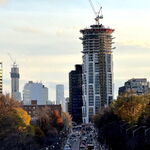Naw, that's for miketoronto;-)
But anyway, three points...
1) as I get older, I tend to be more and more of a jaded anthropologically-minded relativist re matters of "proportion" and "taste". Y'know, my world includes both Measha Brueggergosman *and* Black Oak Arkansas. That sorta thang. Thus, I've come around to realizing that to fussily fret over the Morgan's design "solecisms" is just that--fussy fretting. (That's what makes a lot of those old Montgomery Schuyler fin-de-siecle skyscraper critiques little more than puzzling curiosities today.) What matters is the general effect, i.e. the "Central Park Westing" of Spadina--and IMO the Morgan *does* pull it off well, to the point where one can forgive its imperfections. (For that matter, an argument can be made that it's *better* for its "imperfections", whereas something as "perfect" as, say, 1 St. Thomas, can come off as effetely dull as dishwater. Too much perfection is a bore, y'know.) Meanwhile, District Lofts pulls *its* thing off well, too; and yes, I, too, am more "naturally" stylistically disposed t/w DL--but don't automatically assume that criticisms of its supposed barrenness and pretentious arbitrariness are off a certain mark, either...and be prepared to forgive *those*, too. For me, DL and Morgan are an accidental-yet-fortuitous urban ensemble--in the best way.
2) but granted, re the "why can't we all just get along" point, let me say this much: I can sense the trajectory of cultural/taste judgment re architecture and the urban environment heading from a pattern of greater expansiveness--exactly the sort of pattern that breeds relativists like myself--to a pattern of greater segmentation. Y'know, a red/blue state phenomenon, poisoned by the third primary colour of jaundice. Which, in effect, is a death blow to "just getting along"...
3) and an interesting semiotic question. Why is it that we tend to be more forgiving of retro-styled condos and skyscrapers than retro-styled private residences (i.e. McMansions and their like)? It sure says something about the power of raw urbanism, as opposed to suburbanism...




